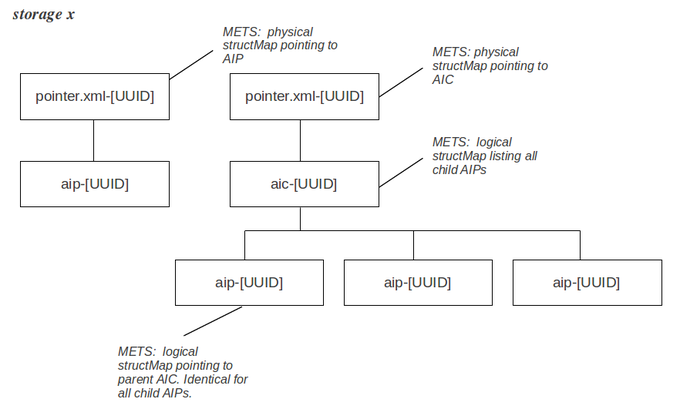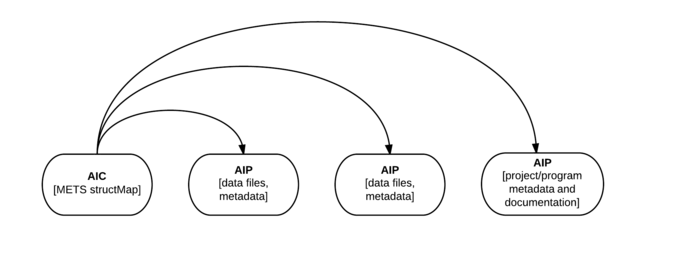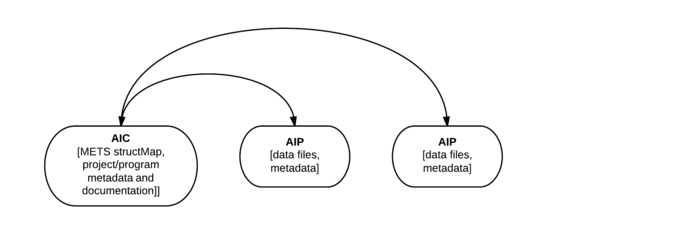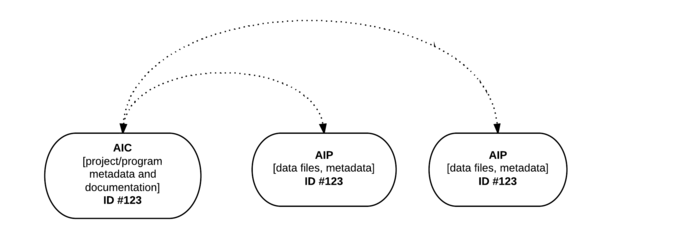Difference between revisions of "Dataset preservation"
| Line 153: | Line 153: | ||
</br> | </br> | ||
| − | '''Cons''' | + | '''Cons''': |
*User has to maintain copies of project/program-level metadata and documentation outside of Archivematica so they can be added to each AIP | *User has to maintain copies of project/program-level metadata and documentation outside of Archivematica so they can be added to each AIP | ||
*Updating the project/program-level metadata and documentation would require re-processing the AIPs | *Updating the project/program-level metadata and documentation would require re-processing the AIPs | ||
Revision as of 19:01, 12 June 2013
Workflow
- Metadata ingest: Metadata will be created outside of Archivematica prior to ingest and added to the metadata folder of the transfer. See Metadata, below.
- Metadata validation: Archivematica should include a micro-service to validate metadata on ingest, using something like xmllint. Sample validation command: xmllint --schema ddi:instance:3_1 metadata/CCRI-CDN-Census1911V20110628.xml.
- Normalization:Some datasets may require manual normalization: see https://projects.artefactual.com/issues/1499.
Metadata
METS and DDI/FGDC
- DDI is Data Documentation Initiative, a metadata specification for the social and behavioral sciences; see http://www.ddialliance.org/.
- FGDC is Federal Geographic Data Committee Metadata Standard [FGDC-STD-001-1998]; see http://www.fgdc.gov/metadata/csdgm/
- DDI and FGDC are considered descriptive metadata (mdSec) in METS. From http://www.loc.gov/standards/mets/METSOverview.v2.html: "Valid values for the MDTYPE element [in mdSec] include...DDI (Data Documentation Initiative), FGDC (Federal Geographic Data Committee Metadata Standard [FGDC-STD-001-1998]."
- In the Archivematica METS file, a DDI or FGDC file could be referenced from the mdSec using mdRef, for example as follows: <mdRef LABEL="CCRI-CDN-Census1911V20110628.xml-73b93b28-be1b-433f-861e-03bc321dfe7e" xlink:href="metadata/CCRI-CDN-Census1911V20110628.xml" MDTYPE="DDI" LOCTYPE="OTHER" OTHERLOCTYPE="SYSTEM"/>.
METS and other metadata standards
- Other metadata standards that could be used for ingested datasets include:
- North American Profile (NAP) of ISO 19119, for geospatial metadata: http://www.fgdc.gov/metadata/geospatial-metadata-standards
- SDMX for aggregate data: http://sdmx.org/?page_id=10
- EML, the Ecological Metadata Language: http://knb.ecoinformatics.org/software/eml/eml-2.1.1/index.html
- If these standards are used, the mdRef in the METS file would need to use OTHER as MDTYPE, for example: <mdRef LABEL="CCRI-CDN-Census1911V20110628.xml-73b93b28-be1b-433f-861e-03bc321dfe7e" xlink:href="metadata/CCRI-CDN-Census1911V20110628.xml" MDTYPE="OTHER" OTHERMDTYPE="SDMX" LOCTYPE="OTHER" OTHERLOCTYPE="SYSTEM"/>
Hierarchical AIC/AIP structure
- Because datasets can be large and heterogeneous, one "dataset" may be broken into multiple AIPs. In such cases, the multiple AIPs can be intellectually combined into one AIC, or Archival Information Collection, defined by the OAIS reference model as "[a]n Archival Information Package whose Content Information is an aggregation of other Archival Information Packages." (OAIS 1-9).
- The AIC may consist of a METS file with aggregate-level descriptive metadata (eg metadata for the dataset or study as a whole) plus a logical structMap listing all child AIPs (see options and variations in Possible AIC/AIP designs, below.
- In storage, a pointer.xml file gives the uri and extraction (eg unzipping) information for an AIC or stand-alone AIP. Question: does the pointer.xml file give the uri and extraction info for AIPs that are children of AICs, or is that information captured in the AIC?
Possible AIC/AIP designs
Option 1
Description: An AIC consisting of only a structMap; AIPs consisting of data files and metadata for those data files; an AIP consisting of project/program-level (i.e. dataset) metadata and documentation.
Workflow:
- User creates X number of AIPs and puts them in archival storage
- One of these AIPs consists only of metadata and documentation about the program/project as a whole
- The AIPs must have one or more common metadata elements that allows them to be identified as being related
- User searches for AIPs in archival storage tab
- Once search results are retrieved, user clicks "Create AIC" button
- AIC is created, containing only a METS structMap listing all AIPs
- Over time, user can add new AIPs and re-create the AIC at any time; the new AIC should replace the old one
- Over time, if needed the user either updates the existing documentation AIP or adds new documentation AIPs (i.e. there can be more than one documentation AIP per dataset)
Pros:
- Don't have to duplicate program/project-level documentation in each AIP
- Simple workflow for creating AIC
- Easy to add new AIPs
- If program/project documentation needs updating, only one AIP has to be re-processed, or user can add new documentation AIP(s)
Cons:
- There is only a one-way link between the AIC and child AIPs - i.e. the AIC has a structMap listing all child AIPs, but there is nothing in a child AIP to indicate that it belongs to a given AIC.
Questions:
- How do we distinguish the documentation AIP from the content AIPs? Maybe through transfer naming conventions?
Option 2
Description: An AIC consisting of a METS structMap and project/program-level (i.e. dataset) metadata and documentation; content AIPs consisting of data files and metadata about the data files. AIPs have information in the METS files linking them to the parent AIC.
Workflow: To be determined - probably a dashboard tab with a gui to allow users to arrange existing AIPs into an AIC
Pros:
- Don't have to duplicate program/project-level documentation in each AIP
- AIPs have a link up to the AIC, so if an AIP is orphaned the relationship to the AIC can easily be reconstructed
- If program/project-level metadata and documentation needs to be updated, only the AIC needs to be re-processed
Cons:
- Workflow to create this structure may be complex
- No obvious mechanism for adding new AIPs over time
Option 3
Description: An AIC with a unique identifier consisting of project/program-level (i.e. dataset) metadata and documentation only (no structMap); AIPs consisting of data files, metadata for those data files, and the same identifier as the AIC. The relationship between the AIC and AIPs in this scenario is inferred from the matching identifiers.
Workflow:
- User creates an AIC consisting of project/program-level (i.e. dataset) metadata and documentation
- The AIC contains an identifier that distinguishes it from other AICs
- User creates AIPs consisting of data files and metadata for those data files
- User includes the AIC identifier in each AIP
- Over time, if needed the user can add more AIPs with the same identifier
Pros:
- Simple workflow
- Minimal development requirements, just new metadata field for identifier added to transfer tab, corresponding entry in AIC/AIP METS files and ability to search by AIC identifier in archival storage tab
- If program/project-level metadata and documentation needs to be updated, only the AIC needs to be re-processed
- Easy to add more AIPs to the same AIC over time
Cons:
- No structMap in the AIC means that there is no single source of information about how many AIPs are in the AIC
Option 4
Description: No AIC; project/program-level metadata and documentation duplicated in all AIPs; links between AIPs belonging to one dataset inferred from metadata only
Workflow: User creates any number of AIPs with complete copies of the project/program-leve (i.e. dataset) metadata and documentation in each AIP
Pros:
- No new Archivematica development required
- Easy to add new AIPs over time
Cons:
- User has to maintain copies of project/program-level metadata and documentation outside of Archivematica so they can be added to each AIP
- Updating the project/program-level metadata and documentation would require re-processing the AIPs
- Relationships between AIPs would have to be inferred from matching metadata elements alone




